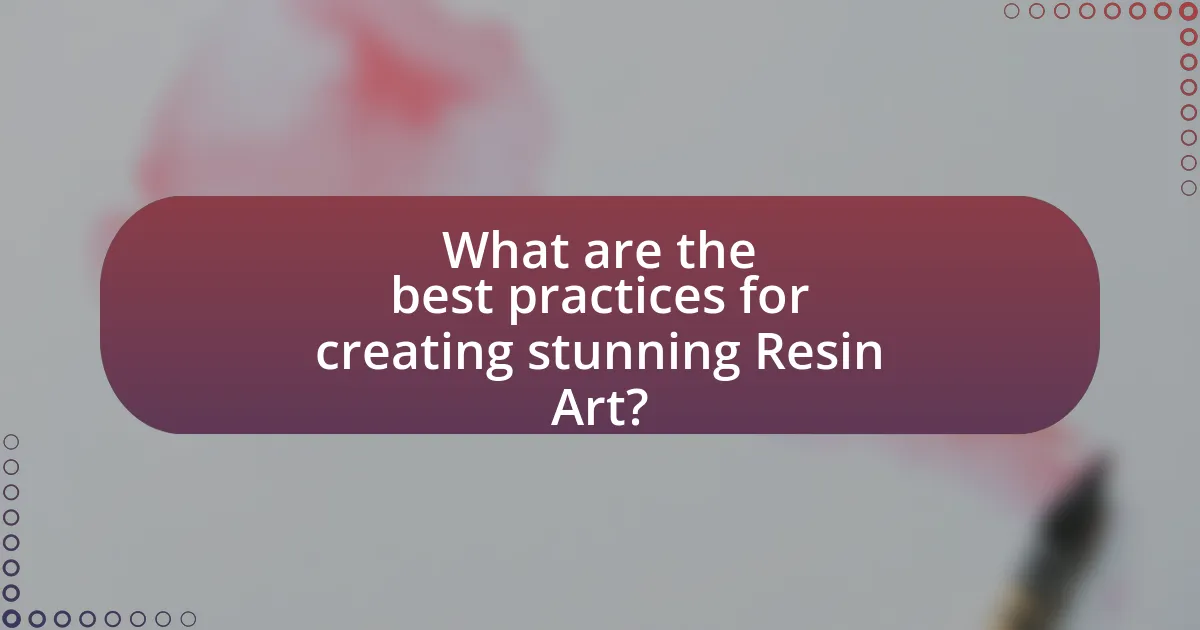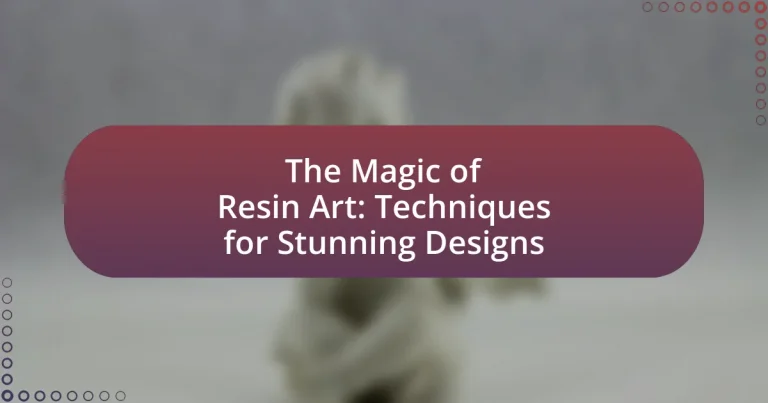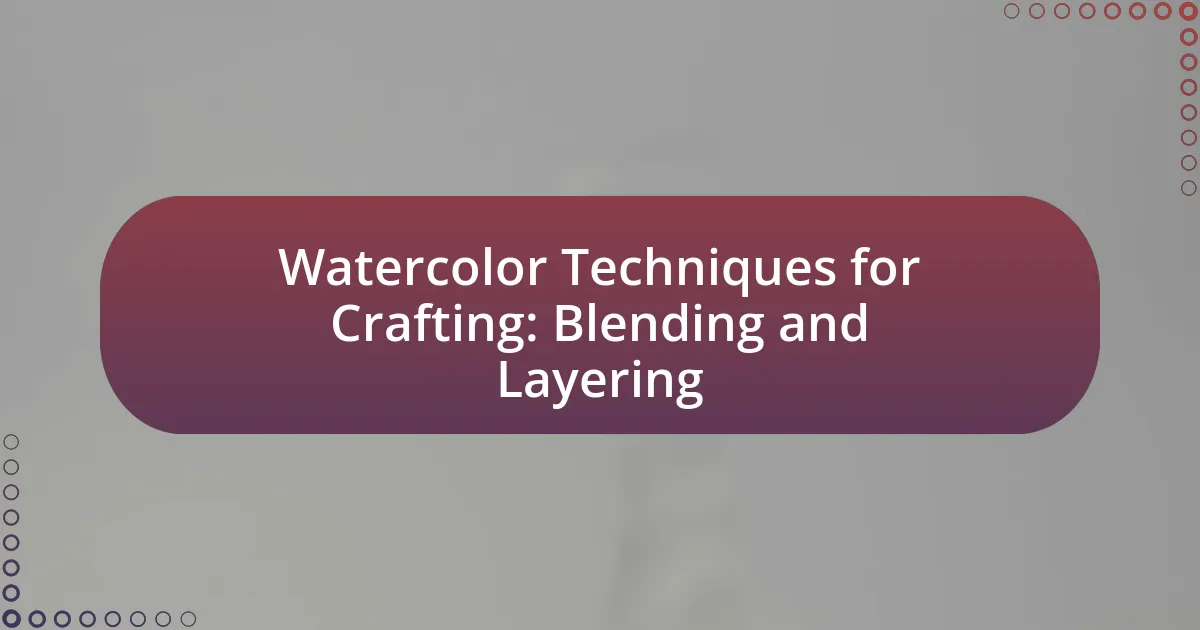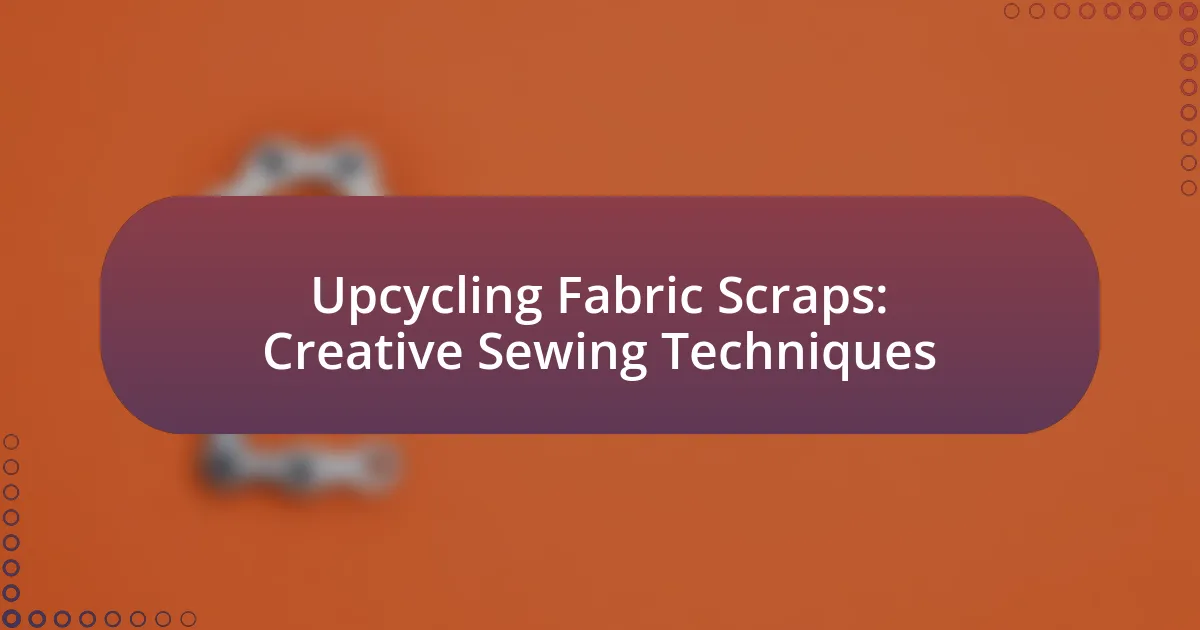Resin art is a creative technique that utilizes epoxy resin to produce visually striking artworks, including paintings, jewelry, and home decor. The article explores the process of creating resin art, detailing essential materials, key steps, and popular techniques such as layering and color mixing. It also discusses the unique properties of resin that enhance artistic expression, the various styles of resin art, and the challenges artists may face, along with best practices for achieving high-quality results. Additionally, safety precautions and troubleshooting tips for common issues like bubbles and improper curing are provided, making it a comprehensive guide for both beginners and experienced artists.

What is Resin Art?
Resin art is a creative technique that involves using epoxy resin to create visually striking artworks and designs. This medium allows artists to manipulate colors, textures, and shapes, resulting in unique pieces that can be used for various applications, including paintings, jewelry, and home decor. The versatility of resin art is supported by its ability to encapsulate objects, create depth, and produce a glossy finish, making it a popular choice among contemporary artists.
How is Resin Art created?
Resin art is created by mixing epoxy resin with a hardener, which, when combined, undergoes a chemical reaction that causes the mixture to cure and harden. Artists typically start by preparing a clean workspace and selecting a mold or surface for their artwork. They then measure and mix the resin and hardener according to the manufacturer’s instructions, ensuring the correct ratio for optimal curing. Once mixed, pigments, dyes, or other additives can be incorporated to achieve desired colors and effects. The mixture is then poured into the mold or onto the surface, where it can be manipulated using tools like heat guns or brushes to create unique designs. After allowing sufficient time for curing, which can range from several hours to days depending on the product, the final piece is demolded or finished. This process is validated by the fact that epoxy resin is widely used in art and crafts due to its durability and versatility, making it a popular choice among artists.
What materials are essential for Resin Art?
The essential materials for Resin Art include epoxy resin, hardener, mixing cups, stir sticks, and protective gear. Epoxy resin serves as the primary medium, while the hardener activates the curing process, creating a solid finish. Mixing cups allow for accurate measurement and mixing of the resin and hardener, and stir sticks facilitate thorough blending. Protective gear, such as gloves and masks, is crucial to ensure safety during the handling of chemicals. These materials are fundamental for creating durable and visually appealing resin art pieces.
What steps are involved in the Resin Art process?
The Resin Art process involves several key steps: preparation, mixing, pouring, and finishing. First, preparation includes gathering materials such as resin, hardener, pigments, and molds, as well as ensuring a clean workspace. Next, mixing involves combining the resin and hardener in the correct ratio, typically 1:1, and adding pigments or other additives to achieve desired colors and effects. After mixing, pouring is the step where the resin mixture is carefully poured into molds or onto surfaces, allowing for creative designs. Finally, finishing includes allowing the resin to cure completely, which can take 24 to 72 hours, and then sanding or polishing the surface to achieve a smooth finish. Each step is crucial for achieving high-quality resin art, as improper mixing or curing can lead to defects in the final product.
Why is Resin Art considered magical?
Resin Art is considered magical because it transforms ordinary materials into stunning, vibrant creations through a unique chemical process. The interaction of resin with pigments and additives allows artists to create mesmerizing patterns and effects that seem to defy reality. This transformative quality is enhanced by the resin’s ability to capture light and depth, resulting in pieces that appear to glow and shift as they are viewed from different angles. The combination of creativity and chemistry in Resin Art captivates both artists and viewers, making the experience feel enchanting and otherworldly.
What unique properties does resin possess?
Resin possesses unique properties such as high durability, transparency, and versatility. These characteristics make resin an ideal medium for art and design, allowing for intricate details and vibrant colors. The high durability of resin ensures that finished products are resistant to wear and tear, while its transparency enables the creation of stunning visual effects, such as depth and layering. Additionally, resin can be easily molded and shaped, accommodating various artistic techniques and applications, which further enhances its appeal in resin art.
How does resin enhance artistic expression?
Resin enhances artistic expression by providing a versatile medium that allows artists to create intricate designs and vibrant colors. This material can encapsulate objects, create depth, and produce a glossy finish, which elevates the visual appeal of artworks. For instance, resin’s ability to mix with pigments and additives enables artists to achieve unique textures and effects, such as marbling or layering, which are difficult to replicate with traditional mediums. Additionally, the durability and clarity of cured resin ensure that artworks maintain their aesthetic quality over time, making it a favored choice among contemporary artists.
What are the different styles of Resin Art?
The different styles of Resin Art include ocean wave, geode, abstract, and functional art. Ocean wave resin art mimics the appearance of ocean waves using blue and white pigments, often incorporating techniques like swiping and layering. Geode resin art replicates the look of natural geodes, utilizing crystals and vibrant colors to create depth and texture. Abstract resin art focuses on freeform designs, allowing for creativity and spontaneity with color combinations and shapes. Functional art involves creating usable items, such as coasters or tabletops, while still showcasing artistic elements. Each style employs unique techniques and materials to achieve distinct visual effects.
What are the popular techniques used in Resin Art?
The popular techniques used in Resin Art include the geode technique, the ocean wave technique, and the layering technique. The geode technique involves creating a crystal-like effect by using colored resin and additives like glitter or crystals, mimicking the appearance of natural geodes. The ocean wave technique utilizes various shades of blue and white resin to replicate the look of ocean waves, often incorporating movement through tilting the surface. The layering technique involves pouring multiple layers of resin, allowing each layer to cure before adding the next, which creates depth and dimension in the artwork. These techniques are widely recognized for their ability to produce visually striking and intricate designs in resin art.
How do color choices impact Resin Art designs?
Color choices significantly impact Resin Art designs by influencing the overall aesthetic, emotional response, and visual harmony of the artwork. The selection of colors can create specific moods; for instance, warm colors like reds and yellows evoke energy and warmth, while cool colors such as blues and greens promote calmness and tranquility. Additionally, contrasting colors can enhance depth and dimension, making the artwork more dynamic. Research indicates that color psychology plays a crucial role in how viewers perceive art, with studies showing that color combinations can affect emotional reactions and engagement levels. Therefore, thoughtful color selection is essential for achieving desired artistic effects in Resin Art.
How can one get started with Resin Art?
To get started with Resin Art, one should first gather essential materials, including epoxy resin, hardener, mixing cups, stir sticks, and protective gear. These materials are crucial as they ensure safety and proper mixing, which is vital for achieving desired results. Next, one should choose a workspace that is well-ventilated and covered to protect surfaces from spills. Following this, it is important to read and understand the instructions provided by the resin manufacturer, as different products may have varying mixing ratios and curing times. Finally, experimenting with colors and techniques, such as pouring, swirling, or layering, allows for creativity and skill development in creating stunning designs.
What safety precautions should be taken when working with resin?
When working with resin, it is essential to wear personal protective equipment (PPE) such as gloves, goggles, and a respirator to prevent skin contact, eye irritation, and inhalation of harmful fumes. Additionally, working in a well-ventilated area minimizes exposure to volatile organic compounds (VOCs) released during the curing process. According to the Material Safety Data Sheet (MSDS) for epoxy resins, prolonged exposure can lead to sensitization and other health risks, reinforcing the importance of these precautions.

What techniques can be used for stunning Resin Art designs?
Techniques for stunning Resin Art designs include the use of color mixing, layering, and incorporating additives like glitter or pigments. Color mixing allows artists to create unique shades and effects, enhancing the visual appeal of the artwork. Layering involves pouring multiple layers of resin, which can create depth and dimension in the final piece. Additionally, incorporating additives such as glitter, metallic powders, or even natural elements like flowers can add texture and interest, making the designs more captivating. These techniques are widely recognized in the resin art community for their effectiveness in producing eye-catching results.
How can layering techniques enhance Resin Art?
Layering techniques can enhance Resin Art by creating depth and dimension in the artwork. This method allows artists to build multiple layers of resin, each with different colors, textures, or embedded materials, resulting in a visually striking piece. For instance, by pouring a colored resin layer and allowing it to cure before adding another layer, artists can achieve a three-dimensional effect that draws the viewer’s eye. Additionally, layering can facilitate the incorporation of various elements, such as glitter or natural materials, which can be suspended between layers, further enriching the visual complexity of the art.
What is the process for creating layered designs?
The process for creating layered designs involves preparing a base layer, pouring resin, allowing it to cure, and then adding subsequent layers. Initially, the artist prepares a clean workspace and selects a mold or surface for the design. The first layer of resin is mixed according to the manufacturer’s instructions and poured into the mold, ensuring an even distribution. After this layer cures, which typically takes several hours to a day depending on the resin type, the artist can add additional layers by repeating the mixing and pouring process, often incorporating colors, textures, or objects between layers. This method allows for depth and complexity in the final design, as each layer interacts with the others. The effectiveness of this process is supported by the fact that layered resin art can create stunning visual effects, as seen in various resin art showcases and exhibitions.
How do different resin types affect layering?
Different resin types significantly affect layering by influencing adhesion, curing time, and clarity. For instance, epoxy resin typically provides strong adhesion between layers, allowing for seamless transitions, while polyester resin may not bond as effectively, leading to potential delamination. Additionally, the curing time varies; fast-curing resins can create a more challenging layering process due to shorter working times, whereas slow-curing resins allow for better manipulation and blending of layers. Clarity also differs; clear resins enhance the visual depth of layered designs, while colored or opaque resins can alter the overall aesthetic. These characteristics are crucial for achieving desired effects in resin art.
What role does color mixing play in Resin Art?
Color mixing is essential in Resin Art as it allows artists to create a wide range of hues and effects, enhancing the visual appeal of their work. By combining different pigments or dyes, artists can achieve unique color gradients, depth, and dimension, which are crucial for creating stunning designs. For instance, using complementary colors can produce vibrant contrasts, while analogous colors can create harmonious blends. This versatility in color mixing not only contributes to the aesthetic quality of the artwork but also enables artists to express their creativity and individuality through their pieces.
How can color theory be applied to Resin Art?
Color theory can be applied to Resin Art by utilizing the principles of color harmony, contrast, and the emotional impact of colors to create visually appealing designs. Artists can use complementary colors to enhance vibrancy and create focal points, while analogous colors can provide a sense of unity and flow within the artwork. Additionally, understanding color temperature—warm versus cool colors—allows artists to evoke specific moods or atmospheres in their pieces. For instance, warm colors can create feelings of warmth and energy, while cool colors can impart calmness and serenity. This application of color theory not only enhances the aesthetic quality of Resin Art but also engages viewers on an emotional level, making the artwork more impactful.
What are the best practices for mixing colors in resin?
The best practices for mixing colors in resin include using high-quality pigments, measuring components accurately, and mixing thoroughly to ensure even color distribution. High-quality pigments provide vibrant and consistent colors, while accurate measurements of resin and hardener prevent issues with curing. Thorough mixing, typically for at least three minutes, ensures that the color is evenly dispersed throughout the resin, which is crucial for achieving the desired visual effect. Additionally, it is advisable to mix colors in small batches to maintain control over the final outcome and to test color combinations on a small scale before applying them to larger projects.
How can texture be incorporated into Resin Art?
Texture can be incorporated into Resin Art by using various materials and techniques that create depth and dimension. Artists can add elements such as sand, fabric, or natural materials like leaves and stones directly into the resin mixture, which enhances the tactile quality of the artwork. Additionally, techniques like layering different colors of resin or using tools to manipulate the surface can create visual texture. Research indicates that incorporating these elements not only adds aesthetic appeal but also engages viewers on a sensory level, making the artwork more dynamic and interesting.
What materials can be used to create texture in resin?
Various materials can be used to create texture in resin, including sand, glitter, pigments, and natural elements like leaves or flowers. Sand adds a gritty texture, while glitter can provide sparkle and depth. Pigments allow for color variation and can create a marbled effect when swirled. Natural elements, such as dried flowers or leaves, introduce organic textures and visual interest. These materials can be mixed into the resin or layered to achieve the desired effect, enhancing the overall aesthetic of the resin art piece.
How does texture influence the final appearance of the artwork?
Texture significantly influences the final appearance of artwork by affecting visual depth, light reflection, and tactile engagement. In resin art, varying textures can create dynamic surfaces that enhance the overall aesthetic, making the piece more visually interesting and engaging. For instance, a smooth texture may reflect light uniformly, while a rough texture can create shadows and highlights, adding complexity to the visual experience. Studies in art theory indicate that texture can evoke emotional responses and alter perceptions of the artwork, reinforcing its impact on viewers.
What are common challenges faced in Resin Art?
Common challenges faced in Resin Art include issues with curing, bubbles, and color mixing. Curing problems arise when the resin does not harden properly, often due to incorrect mixing ratios or environmental factors like temperature and humidity. Bubbles can form during the mixing process or when pouring, which can compromise the aesthetic quality of the artwork. Additionally, achieving the desired color can be difficult, as resin can alter the appearance of pigments once cured. These challenges are well-documented in resin art communities and tutorials, highlighting the importance of precise measurements and techniques to mitigate these issues.
How can one troubleshoot bubbles in resin?
To troubleshoot bubbles in resin, one should first ensure that the resin is mixed thoroughly and slowly to minimize air entrapment. Mixing at a slower speed reduces the introduction of bubbles, as rapid stirring can create more air pockets. Additionally, heating the resin slightly before mixing can lower its viscosity, allowing bubbles to rise to the surface more easily.
Using a heat gun or torch after pouring can also help eliminate surface bubbles, as the heat causes the bubbles to expand and pop. It is important to maintain a safe distance to avoid overheating the resin. Furthermore, pouring the resin in thin layers can reduce the likelihood of bubbles forming, as thicker pours tend to trap more air.
These methods are supported by practical experience in resin art, where artists frequently apply these techniques to achieve clear, bubble-free finishes.
What methods can prevent resin from curing improperly?
To prevent resin from curing improperly, ensure accurate measurement of resin and hardener, maintain optimal temperature and humidity levels, and mix thoroughly. Accurate measurement is crucial because improper ratios can lead to incomplete curing; for example, a common ratio is 1:1 for many epoxy resins. Maintaining a temperature between 70°F and 85°F (21°C to 29°C) is essential, as lower temperatures can slow the curing process, while higher temperatures can cause it to accelerate too quickly. Additionally, mixing the resin and hardener for at least three minutes, scraping the sides and bottom of the mixing container, ensures a uniform blend, which is vital for proper curing.

What are the best practices for creating stunning Resin Art?
The best practices for creating stunning Resin Art include using high-quality resin, ensuring proper mixing, and maintaining a clean workspace. High-quality resin, such as epoxy resin, provides clarity and durability, which are essential for visual appeal. Proper mixing, typically a 1:1 ratio of resin to hardener, is crucial to avoid issues like cloudiness or incomplete curing. A clean workspace prevents dust and debris from contaminating the artwork, ensuring a smooth finish. Additionally, incorporating techniques like layering, using heat guns to eliminate bubbles, and experimenting with colors can enhance the overall design. These practices are supported by numerous artists who emphasize the importance of quality materials and meticulous processes in achieving professional results.
How can beginners improve their Resin Art skills?
Beginners can improve their Resin Art skills by practicing fundamental techniques such as mixing resin accurately, controlling temperature, and experimenting with color combinations. Mastery of these basics is essential, as improper mixing can lead to bubbles and uneven curing, while temperature affects the viscosity and curing time of the resin. Additionally, utilizing tutorials and online resources can provide valuable insights and tips from experienced artists, enhancing learning and skill development. Engaging in regular practice and seeking feedback from the resin art community can further accelerate improvement, as collaboration and critique foster growth and innovation in artistic techniques.
What tips can enhance the overall quality of Resin Art projects?
To enhance the overall quality of Resin Art projects, use high-quality resin and ensure proper mixing ratios. High-quality resin minimizes imperfections and enhances clarity, while accurate mixing ratios prevent issues like bubbles and incomplete curing. Additionally, working in a dust-free environment and using a heat gun or torch can help eliminate bubbles and improve the finish. Finally, incorporating colorants and additives specifically designed for resin can elevate the aesthetic appeal and depth of the artwork.




